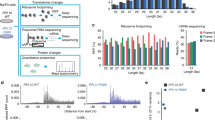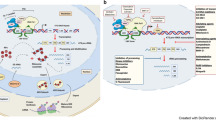Abstract
Several somatic ribosome defects have recently been discovered in cancer, yet their oncogenic mechanisms remain poorly understood. Here we investigated the pathogenic role of the recurrent R98S mutation in ribosomal protein L10 (RPL10 R98S) found in T-cell acute lymphoblastic leukemia (T-ALL). The JAK-STAT signaling pathway is a critical controller of cellular proliferation and survival. A proteome screen revealed overexpression of several Jak-Stat signaling proteins in engineered RPL10 R98S mouse lymphoid cells, which we confirmed in hematopoietic cells from transgenic Rpl10 R98S mice and T-ALL xenograft samples. RPL10 R98S expressing cells displayed JAK-STAT pathway hyper-activation upon cytokine stimulation, as well as increased sensitivity to clinically used JAK-STAT inhibitors like pimozide. A mutually exclusive mutation pattern between RPL10 R98S and JAK-STAT mutations in T-ALL patients further suggests that RPL10 R98S functionally mimics JAK-STAT activation. Mechanistically, besides transcriptional changes, RPL10 R98S caused reduction of apparent programmed ribosomal frameshifting at several ribosomal frameshift signals in mouse and human Jak-Stat genes, as well as decreased Jak1 degradation. Of further medical interest, RPL10 R98S cells showed reduced proteasome activity and enhanced sensitivity to clinical proteasome inhibitors. Collectively, we describe modulation of the JAK-STAT cascade as a novel cancer-promoting activity of a ribosomal mutation, and expand the relevance of this cascade in leukemia.
This is a preview of subscription content, access via your institution
Access options







Similar content being viewed by others
References
Pui C-H, Robison LL, Look AT . Acute lymphoblastic leukaemia. Lancet 2008; 371: 1030–1043.
Vicente C, Schwab C, Broux M, Geerdens E, Degryse S, Demeyer S et al. Targeted sequencing identifies associations between IL7R-JAK mutations and epigenetic modulators in T-cell acute lymphoblastic leukemia. Haematologica 2015; 100: 1301–1310.
Zhang J, Ding L, Holmfeldt L, Wu G, Heatley SL, Payne-Turner D et al. The genetic basis of early T-cell precursor acute lymphoblastic leukaemia. Nature 2012; 481: 157–163.
Canté-Barrett K, Spijkers-Hagelstein JAP, Buijs-Gladdines JGCAM, Uitdehaag JCM, Smits WK, van der Zwet J et al. MEK and PI3K-AKT inhibitors synergistically block activated IL7 receptor signaling in T-cell acute lymphoblastic leukemia. Leukemia 2016; 30: 1832–1843.
Girardi T, Vicente C, Cools J, De Keersmaecker K . The genetics and molecular biology of T-ALL. Blood 2017; 129: 1113–1123.
De Keersmaecker K, Atak ZK, Li N, Vicente C, Patchett S, Girardi T et al. Exome sequencing identifies mutation in CNOT3 and ribosomal genes RPL5 and RPL10 in T-cell acute lymphoblastic leukemia. Nat Genet 2012; 45: 186–190.
Rao S, Lee S-Y, Gutierrez A, Perrigoue J, Thapa RJ, Tu Z et al. Inactivation of ribosomal protein L22 promotes transformation by induction of the stemness factor, Lin28B. Blood 2012; 120: 3764–3773.
Tzoneva G, Perez-Garcia A, Carpenter Z, Khiabanian H, Tosello V, Allegretta M et al. Activating mutations in the NT5C2 nucleotidase gene drive chemotherapy resistance in relapsed ALL. Nat Med 2013; 19: 368–371.
Fancello L, Kampen KR, Hofman IJF, Verbeeck J, De Keersmaecker K . The ribosomal protein gene RPL5 is a haploinsufficient tumor suppressor in multiple cancer types. Oncotarget 2017; 8: 14462–14478.
Hofman IJF, Van Duin M, De Bruyne E, Fancello L, Mulligan G, Geerdens E et al. RPL5 on 1p22.1 is recurrently deleted in multiple myeloma and its expression is linked to bortezomib response. Leukemia 2017; 31: 1706–1714.
Landau DA, Tausch E, Taylor-Weiner AN, Stewart C, Reiter JG, Bahlo J et al. Mutations driving CLL and their evolution in progression and relapse. Nature 2015; 526: 525–530.
Ljungstrom V, Cortese D, Young E, Pandzic T, Mansouri L, Plevova K et al. Whole-exome sequencing in relapsing chronic lymphocytic leukemia: clinical impact of recurrent RPS15 mutations. Blood 2015; 127: 1007–1016.
Morgado-Palacin L, Varetti G, Llanos S, Gómez-López G, Martinez D, Serrano M . Partial loss of Rpl11 in adult mice recapitulates Diamond-Blackfan anemia and promotes lymphomagenesis. Cell Rep 2015; 13: 712–722.
Amsterdam A, Sadler KC, Lai K, Farrington S, Bronson RT, Lees JA et al. Many ribosomal protein genes are cancer genes in zebrafish. PLoS Biol 2004; 2: e139.
De Keersmaecker K, Sulima SO, Dinman JD . Ribosomopathies and the paradox of cellular hypo- to hyperproliferation. Blood 2015; 125: 1377–1382.
Narla A, Ebert BL . Ribosomopathies: human disorders of ribosome dysfunction. Blood 2010; 115: 3196–3205.
Zhou X, Liao W-J, Liao J-M, Liao P, Lu H . Ribosomal proteins: functions beyond the ribosome. J Mol Cell Biol 2015; 7: 92–104.
Ban N, Beckmann R, Cate JHD, Dinman JD, Dragon F, Ellis SR et al. A new system for naming ribosomal proteins. Curr Opin Struct Biol 2014; 24: 165–169.
Sulima SO, Patchett S, Advani VM, De Keersmaecker K, Johnson AW, Dinman JD . Bypass of the pre-60S ribosomal quality control as a pathway to oncogenesis. Proc Natl Acad Sci USA 2014; 111: 5640–5645.
Sulima SO, Gülay SP, Anjos M, Patchett S, Meskauskas A, Johnson AW et al. Eukaryotic rpL10 drives ribosomal rotation. Nucleic Acids Res 2013; 42: 2049–2063.
Subramanian A, Tamayo P, Mootha VK, Mukherjee S, Ebert BL, Gillette MA et al. Gene set enrichment analysis: a knowledge-based approach for interpreting genome-wide expression profiles. Proc Natl Acad Sci USA 2005; 102: 15545–15550.
Mootha VK, Lindgren CM, Eriksson K-F, Subramanian A, Sihag S, Lehar J et al. PGC-1α-responsive genes involved in oxidative phosphorylation are coordinately downregulated in human diabetes. Nat Genet 2003; 34: 267–273.
Belew AT, Hepler NL, Jacobs JL, Dinman JD . PRFdb: a database of computationally predicted eukaryotic programmed -1 ribosomal frameshift signals. BMC Genomics 2008; 9: 339.
Reimand J, Arak T, Adler P, Kolberg L, Reisberg S, Peterson H et al. g:Profiler-a web server for functional interpretation of gene lists (2016 update). Nucleic Acids Res 2016; 44: W83–W89.
Harger JW, Dinman JD . An in vivo dual-luciferase assay system for studying translational recoding in the yeast Saccharomyces cerevisiae. RNA 2003; 9: 1019–1024.
Grentzmann G, Ingram JA, Kelly PJ, Gesteland RF, Atkins JF . A dual-luciferase reporter system for studying recoding signals. RNA 1998; 4: 479–486.
Jacobs JL, Dinman JD . Systematic analysis of bicistronic reporter assay data. Nucleic Acids Res 2004; 32: e160.
van Vlierberghe P, Ferrando A . The molecular basis of T cell acute lymphoblastic leukemia. J Clin Invest 2012; 122: 3398–3406.
Hara T, Miyajima A . Two distinct functional high affinity receptors for mouse interleukin-3 (IL-3). EMBO J 1992; 11: 1875–1884.
Vainchenker W, Constantinescu SN . JAK/STAT signaling in hematological malignancies. Oncogene 2012; 32: 2601–2613.
Ribeiro D, Melão A, Barata JT . IL-7R-mediated signaling in T-cell acute lymphoblastic leukemia. Adv Biol Regul 2012; 53: 211–222.
Advani VM, Dinman JD . Reprogramming the genetic code: The emerging role of ribosomal frameshifting in regulating cellular gene expression. Bioessays 2015; 38: 21–26.
Belew AT, Meskauskas A, Musalgaonkar S, Advani VM, Sulima SO, Kasprzak WK et al. Ribosomal frameshifting in the CCR5 mRNA is regulated by miRNAs and the NMD pathway. Nature 2014; 512: 265–269.
Truitt ML, Ruggero D . New frontiers in translational control of the cancer genome. Nat Rev Cancer 2016; 16: 288–304.
Bezzerri V, Vella A, Calcaterra E, Finotti A, Gasparello J, Gambari R et al. New insights into the Shwachman–Diamond Syndrome-related haematological disorder: hyper-activation of mTOR and STAT3 in leukocytes. Sci Rep 2016; 6: 33165.
Weis F, Giudice E, Churcher M, Jin L, Hilcenko C, Wong CC et al. Mechanism of eIF6 release from the nascent 60S ribosomal subunit. Nat Struct Mol Biol 2015; 22: 914–919.
Anzalone AV, Lin AJ, Zairis S, Rabadan R, Cornish VW . Reprogramming eukaryotic translation with ligand-responsive synthetic RNA switches. Nat Methods 2016; 13: 453.
Li Y, Treffers EE, Napthine S, Tas A, Zhu L, Sun Z et al. Transactivation of programmed ribosomal frameshifting by a viral protein. Proc Natl Acad Sci USA 2014; 111: E2172.
Klare N, Seeger M, Janek K, Jungblut PR, Dahlmann B . Intermediate-type 20S proteasomes in HeLa cells: ‘asymmetric’ subunit composition, diversity and adaptation. J Mol Biol 2007; 373: 1–10.
Dahlmann B, Ruppert T, Kuehn L, Merforth S, Kloetzel PM . Different proteasome subtypes in a single tissue exhibit different enzymatic properties. J Mol Biol 2000; 303: 643–653.
Huber EM, Basler M, Schwab R, Heinemeyer W, Kirk CJ, Groettrup M et al. Immuno- and constitutive proteasome crystal structures reveal differences in substrate and inhibitor specificity. Cell 2012; 148: 727–738.
Mishto M, Liepe J, Textoris-Taube K, Keller C, Henklein P, Weberruß M et al. Proteasome isoforms exhibit only quantitative differences in cleavage and epitope generation. Eur J Immunol 2014; 44: 3508–3521.
Tremblay CS, Brown FC, Collett M, Saw J, Chiu SK, Sonderegger SE et al. Loss-of-function mutations of Dynamin 2 promote T-ALL by enhancing IL-7 signalling. Leukemia 2016; 30: 1993–2001.
Goossens S, Radaelli E, Blanchet O, Durinck K, Van der Meulen J, Peirs S et al. ZEB2 drives immature T-cell lymphoblastic leukaemia development via enhanced tumour-initiating potential and IL-7 receptor signalling. Nat Commun 2015; 6: 5794.
Degryse S, de Bock CE, Cox L, Demeyer S, Gielen O, Mentens N et al. JAK3 mutants transform hematopoietic cells through JAK1 activation, causing T-cell acute lymphoblastic leukemia in a mouse model. Blood 2014; 124: 3092–3100.
Schafranek L, Nievergall E, Powell JA, Hiwase DK, Leclercq T, Hughes TP et al. Sustained inhibition of STAT5, but not JAK2, is essential for TKI-induced cell death in chronic myeloid leukemia. Leukemia 2014; 29: 76–85.
Nelson EA, Walker SR, Xiang M, Weisberg E, Bar-Natan M, Barrett R et al. The STAT5 inhibitor pimozide displays efficacy in models of acute myelogenous leukemia driven by FLT3 mutations. Genes Cancer 2012; 3: 503–511.
Acknowledgements
We thank the EPFL proteomics core facility and the VIB Nucleomics core facility for their excellent support on mass spectrometry and RNA sequencing respectively. We thank Somersault1824 for preparing Figure 7. TG is funded by the fellowship ‘Emmanuel van der Schueren’ Kom op tegen kanker. SOS was supported by a long-term EMBO Fellowship (ALTF 1263-2014), the European Commission and Marie Curie Actions (LTFCOFUND2013, GA-2013-609409) and by a José Carreras EHA junior research grant. SV is SB PhD fellow at FWO (n° 1S49817N). KRK is supported by the Lady Tata Memorial Trust International Award for research in Leukaemia. This research was funded by an ERC starting grant (n° 334946), FWO funding (G067015N, G084013N and 1509814N) and a Stichting Tegen Kanker grant (grant n° 2012-176) to KDK. This work was partially supported by funding to JDD by the National Institutes of Health (R01HL119439 and R01GM117177).
Author contributions
TG, JDD and KDK designed the research. TG, SV, SOS, KRK and SB developed methodology. TG, SV, SOS, KRK, YK, EG, JWB, JODB, JV and JR performed the research. TG, SV, SOS, KRK, YK, LF, CV and KDK analyzed the data. JPM, CS, EG, CJH and JC provided administrative, technical and material support. TG, SV, SOS, LF, CJH, JPM, JC, JDD and KDK wrote and edited the paper. JDD and KDK supervised the study.
Author information
Authors and Affiliations
Corresponding author
Ethics declarations
Competing interests
The authors declare no conflict of interest.
Additional information
Supplementary Information accompanies this paper on the Leukemia website
Supplementary information
Rights and permissions
About this article
Cite this article
Girardi, T., Vereecke, S., Sulima, S. et al. The T-cell leukemia-associated ribosomal RPL10 R98S mutation enhances JAK-STAT signaling. Leukemia 32, 809–819 (2018). https://doi.org/10.1038/leu.2017.225
Received:
Revised:
Accepted:
Published:
Issue Date:
DOI: https://doi.org/10.1038/leu.2017.225
This article is cited by
-
Ribosome profiling: a powerful tool in oncological research
Biomarker Research (2024)
-
The ufmylation modification of ribosomal protein L10 in the development of pancreatic adenocarcinoma
Cell Death & Disease (2023)
-
Molecular profiling of a real-world breast cancer cohort with genetically inferred ancestries reveals actionable tumor biology differences between European ancestry and African ancestry patient populations
Breast Cancer Research (2023)
-
Ribosomal proteins and human diseases: molecular mechanisms and targeted therapy
Signal Transduction and Targeted Therapy (2021)
-
The plasticity of mRNA translation during cancer progression and therapy resistance
Nature Reviews Cancer (2021)



